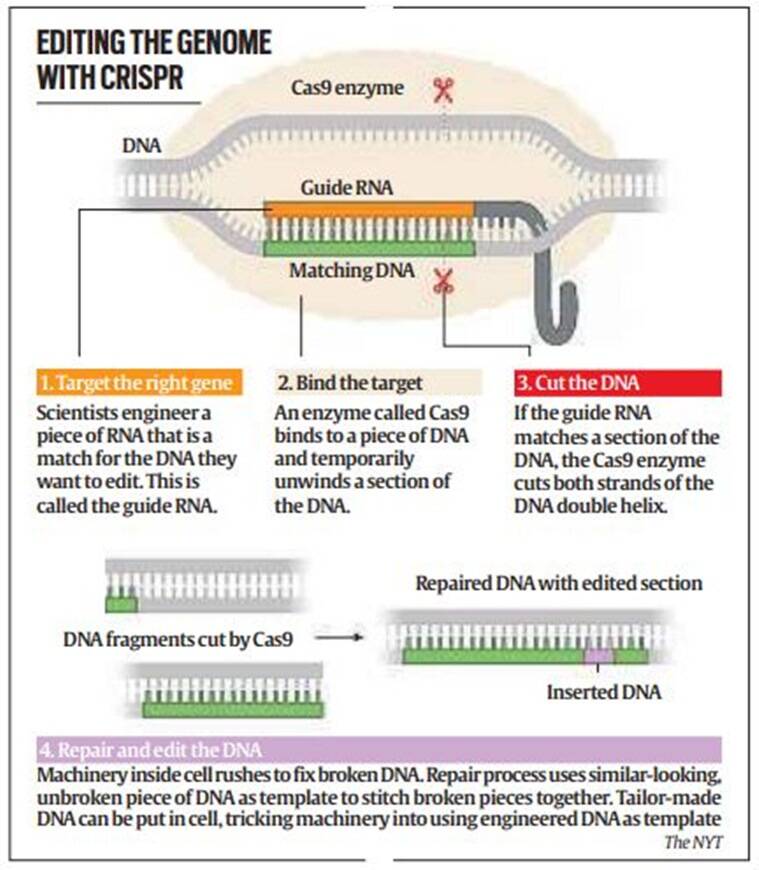Mains > Science and Technology > Bio technology > Basics of biotechnology
Syllabus
GS 3 > Science and Technology > Bio technology > Basics of biotechnology
REFERENCE NEWS
The UK drug regulator last week approved a gene therapy for the cure of sickle cell disease and thalassemia, seen as a landmark breakthrough by many. This is the first licensed therapy in the world based on the gene editing technology Crispr-Cas9 which earned its innovators a Nobel Prize in 2020.
ABOUT CRISPR
CRISPR is short for Clustered Regularly Interspaced Short Palindromic Repeats.
It is a powerful gene editing technology that replicates natural defense mechanisms in bacteria to fight virus attacks using a special protein called Cas9.

WORKING: CRISPR-Cas9 technology behaves like a cut-and-paste mechanism on DNA strands that contain genetic information. The specific location of the genetic codes that need to be changed, or edited, is identified on the DNA strand, and then, using the Cas9 protein, which acts like a pair of scissors, that location is cut off from the strand. A DNA strand, when broken, has a natural tendency to repair itself. Scientists intervene during this auto-repair process, supplying the desired sequence of genetic codes that binds itself with the broken DNA strand.
|
ADVANTAGES OF CRISPR TECHNOLOGY
APPLICATIONS OF CRISPR TECHNOLOGY
Health | Casgevy for Sickle Cell Anemia: The procedure involves modifying the patient's stem cells using CRISPR/Cas9, which are then reinfused into the patient. Casgevy increases the production of fetal hemoglobin, helping prevent red blood cell sickling and alleviating the symptoms of sickle cell anemia. Cancer Therapies: In cancer research, CRISPR-modified immune cells (T-cells) are being developed to recognize and attack cancer cells more effectively. HIV/AIDS: CRISPR is being used experimentally to remove HIV from the DNA of infected cells, offering a potential path towards a cure. Malaria: Some scientists are working to create sterile mosquitoes to prevent the vector-based transmission of diseases like Malaria. |
| Agriculture | Crop Improvement: Researchers can use CRISPR to make precise alterations in plant DNA sequences related to particular traits without adding any foreign DNA. Ex: Japan has already approved the commercial cultivation of a tomato variety that has been improved using CRISPR-based intervention. Animal Breeding: Potential applications include enhancing traits like disease resistance and growth rate in livestock. CRISPR can also be used for conservation efforts, such as reintroducing traits from endangered species. |
Biotechnology &Industrial Applications
| Biofuel Production: CRISPR can improve the efficiency of organisms used in biofuel production, potentially leading to more sustainable energy sources. Bioplastics: The technology can assist in developing microorganisms that produce biodegradable plastics, contributing to reducing plastic pollution. |
Environmental Applications
| Bioremediation: Engineering bacteria or plants to clean up environmental pollutants using CRISPR is a promising area. This application could be vital for addressing issues like oil spills and toxic waste. Invasive Species Control: CRISPR could potentially alter the genes of invasive species to control their populations, though this application is still in the exploratory stages. |
Research Tools
| Functional Genomics: As a research tool, CRISPR is invaluable in studying gene functions and interactions, helping to expand our understanding of genetics. Model Organism Development: It's used to create modified model organisms for research, aiding in the understanding of disease mechanisms and potential treatments. |
Data Storage
| DNA Data Storage: Explorations into using CRISPR for encoding and retrieving information in DNA are underway. This innovative approach could revolutionize how data is stored in the future. |
CHALLENGES ASSOCIATED WITH CRISPR TECHNOLOGY
Ethical Concerns: The possibility of editing genes for non-medical enhancements, like increased intelligence or physical appearance, raises significant ethical questions. Such practices could lead to social inequalities and unintended societal consequences.
"Designer Babies": The potential use of genome editing to create "designer babies" for non-medical reasons, such as social enhancement, is a major ethical concern. This could lead to a societal divide between those who can afford these enhancements and those who cannot.
Off-Target Effects: Gene editing technologies, like CRISPR-Cas9, can sometimes unintentionally alter genes other than the targeted ones. These off-target mutations can have unpredictable and potentially harmful consequences.
Safety Concerns: The procedure of gene editing carries risks, including the possibility of triggering an immune reaction or causing unintended effects like cancer if the wrong gene is edited.
Germline Editing: Germline gene editing, which involves altering the genes of sex cells or early embryos, can lead to changes being passed on to future generations. This raises significant ethical and safety concerns due to the potential for unforeseen and irreversible effects.
Lack of Long-Term Data: The long-term effects of gene editing are not fully understood. There are concerns about the possible unintended consequences of editing genes, which might only become apparent many years later.
Regulatory Challenges: There is currently a lack of a unified regulatory framework for human genome editing. Different countries have varying regulations, which can lead to inconsistencies in standards and practices. Ex: Gene-edited animals are regulated as drugs in the US, whereas in Europe they are considered GMOs.
Ecological Impacts: The use of gene drives in organisms like mosquitoes could have significant ecological impacts. For instance, making mosquitoes resistant to malaria might disrupt the ecosystem if it leads to the decline of mosquito populations.
Uncontrolled Clinical Trials: The absence of standardized norms for clinical trials of genome editing treatments can result in unregulated trials, which may lead to patients receiving ineffective or harmful treatments.
GOVT.SUPPORT
|
WAY FORWARD
Therefore, The future of human genome editing hinges on the delicate balance between scientific advancement and ethical responsibility which can be ensured through collaborative participation from all stakeholders.
For more reading: https://ilearncana.com/details/Gene-editing-and-CRISPR-Cas9/1334
PRACTICE QUESTION
Q: Examine the ethical considerations associated with employing CRISPR-Cas9 for editing genes in human embryos. (10M,150W)